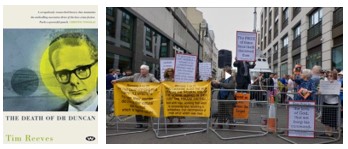A review by John Cook.

I have included a photo of those endlessly tiresome fundamental Christians protesting at the recent London Pride 50th anniversary march in keeping with the continuing outrages that occur against LGBTQI presence and a reminder of what the Dr Duncan case stands for in many people’s minds.
Author Tim Reeves actually completed his Honours thesis 30 years ago on the death of Dr George Ian Ogilvie Duncan and how its response fed into the drive of gay law reform in SA. Much of that detail has been transferred into this book which, as a consequence, is very carefully researched with the data carefully ordered and presented in order to spotlight Duncan’s life and death and the actions of those involved in it at the time and later. An important element is that you will not find confected outrage in these pages. Rather, a reader may come to understand (not forgive) the origin of the behaviours of all involved ranging from the unfortunate victims, possible witnesses, police involvement, and the religious and social attitudes that set the scene for this tragedy.
The story of the investigation of Duncan’s drowning in the Torrens at the site of a well-known beat led, amongst other things, to deep suspicions about the behaviour of the Vice Squad detectives who investigated the offence and who might have been involved in its commission. This process is well explored however unsatisfactory it may have been. I certainly was not aware of the details of that investigative process and its outcomes which were quite unsatisfactory. This not a long book with an appendix of photos that help and a detailed Glossary. It still, for me, had quite a punch.
Duncan was no Turing but there were certain similarities with the existence of two parallel worlds that almost never collided with Duncan being a man, typical of his age, having an existence that appeared almost incredible bland without anything noteworthy apart from his academic record and skills while also clearly knowingly involved in illegal sexual activity that could have a devastating effect if uncovered.
One of the key aspects of the book for me (and its historical context) lies in its relatively non-judgemental exposition of the background influences, so typical of their time, that lay behind individual behaviours of the victims, the investigators, the politicians and other community leaders who reacted in terms of their own conditioning and perceived appropriate advantages. As one who experienced bashing in public places and was well aware of how others of all kinds might respond to me verbalising that in all honesty (including the law), I am acutely aware of so much that transpired in this tale. I comprehend and perhaps understand what happened but remain bitter at how long it took against the odds for some change to arrive.
The role of Scotland Yard in this story is a classic example of ‘buck-passing’ and how to ignore, bury or exhaust findings that powers of the time have been unable to totally suppress. Nothing new there – just a very old avoidance response which continues to this day. Putting anyone in a supervisory role over others sexual behaviour is almost begging for the outcomes seen in vice Squads the world and time over. Money has long been the alternative to a watchhouse stay.
Th bright side of this book lies with the never-ending drive and hard work of reformers to investigate and overturn the laws and mores that persecuted gay men in this respect certainly in SA even when this looked like one step forward and the usual ploy of two backward.
Dr Duncan may not have died in vain but ensuring the protection of individuals and overcoming those who continue to exploit today remains a continuing urgent need.
